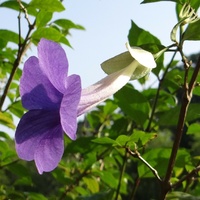Common name: Bush clock vine
Other common names: Bush thunbergia, King's mantle, White bush thunbergia
Description
Bush clock vine is an evergreen shrub originating in tropical West Africa and now widely cultivated in tropical and subtropical gardens worldwide.
In cultivation, it is typically 1 to 3 m (3 to 10 ft) tall with branching starting near the ground and the branches long, slender and drooping, creating a compact, weeping, densely leafy canopy.
Leaves are small, oval with a pointed tip, dark green and arranged along the branches in pairs. They remain on the plant in all seasons, though some leaf fall occurs in areas with a pronounced winter or dry season.
Flowers are trumpet-shaped, large, purple, blue or less commonly white, with yellow tubes and orange throats. They are borne singly and almost continually year-round in warm and humid climates. Blooms are seasonal in areas with cool winters or a long and pronounced dry season.
Use
It is suitable as a hedge, border, privacy screen or container plant. It can also be trained to cascade over and cover garden retaining walls. However, if cultivated as a hedge, frequent trimmings will result in fewer flowers. The flowers attract butterflies.
Climate
It grows naturally in humid tropical lowland climates, generally frost-free areas with annual lows of 16 to 26 °C, annual highs of 25 to 35 °C, annual rainfall of 1200 to 3500 mm and a dry season of 7 months or less, extending to 12 months with irrigation.
Growing
New plants can be grown from seed cuttings. Performs best on moist, fertile, free-draining clay-loam, loam, sandy-loam and loamy-sand soils of a moderately acid to slightly alkaline nature, generally with a pH of 5.0 to 8.0 on sites with full to partial sun exposure. It has moderate tolerance to drought and salt spray.
Problem features
It is assessed as a low weed risk species for Hawaii and Florida, respectively, by the Hawaii Pacific Weed Risk Assessment (HPWRA) project and the IFAS Assessment of Non-Native Plants in Florida's Natural Areas.
Where it grows
References
Books
-
Adams, C. D. 1972, Flowering plants of Jamaica, University of the West Indies, Mona, Greater Kingston
-
Clay, H. et al. 1987, Tropical shrubs, University Press of Hawaii, Honolulu
-
Griffiths, M. & Burras, J. K. 1994, Manual of climbers and wall plants, Royal Horticultural Society (Great Britain), Timber Press, Portland, Oregon
-
Macmillan, H. F. 1943, Tropical planting and gardening : with special reference to Ceylon, 5th ed, Macmillan Publishing, London
-
Oakman, H. 1995, Harry Oakman's what flowers when : the complete guide to flowering times in tropical and subtropical gardens, University of Queensland Press, St. Lucia, Queensland
-
Perry, F. & Hay, R. 1982, A field guide to tropical and subtropical plants, Van Nostrand Reinhold Company, New York
-
Randall, R. P. 2002, A global compendium of weeds, R.G. and F.J. Richardson Press, Melbourne
-
Randall, R. P. 2007, The introduced flora of Australia and its weed status, Cooperative Research Centre for Australian Weed Management, Glen Osmond, South Australia
-
Rauch, F. D. & Weissich, P. R. 2000, Plants for tropical landscapes : a gardener's guide, University of Hawaii Press, Honolulu


